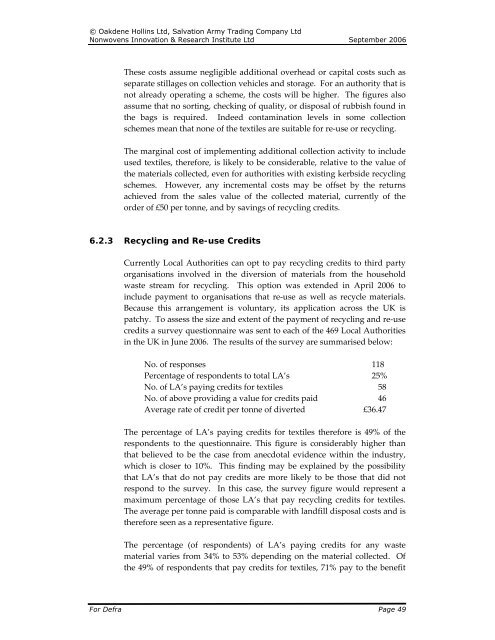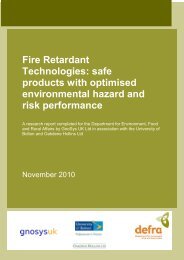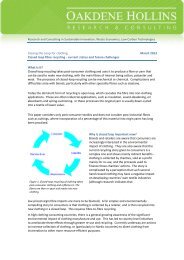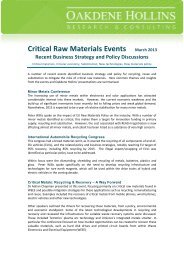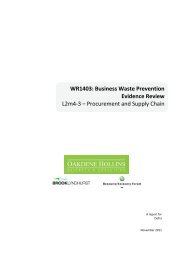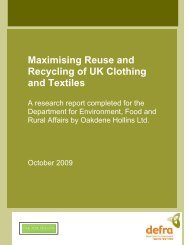Recycling of Low Grade Clothing Waste - Oakdene Hollins
Recycling of Low Grade Clothing Waste - Oakdene Hollins
Recycling of Low Grade Clothing Waste - Oakdene Hollins
Create successful ePaper yourself
Turn your PDF publications into a flip-book with our unique Google optimized e-Paper software.
© <strong>Oakdene</strong> <strong>Hollins</strong> Ltd, Salvation Army Trading Company Ltd<br />
Nonwovens Innovation & Research Institute Ltd September 2006<br />
These costs assume negligible additional overhead or capital costs such as<br />
separate stillages on collection vehicles and storage. For an authority that is<br />
not already operating a scheme, the costs will be higher. The figures also<br />
assume that no sorting, checking <strong>of</strong> quality, or disposal <strong>of</strong> rubbish found in<br />
the bags is required. Indeed contamination levels in some collection<br />
schemes mean that none <strong>of</strong> the textiles are suitable for re‐use or recycling.<br />
The marginal cost <strong>of</strong> implementing additional collection activity to include<br />
used textiles, therefore, is likely to be considerable, relative to the value <strong>of</strong><br />
the materials collected, even for authorities with existing kerbside recycling<br />
schemes. However, any incremental costs may be <strong>of</strong>fset by the returns<br />
achieved from the sales value <strong>of</strong> the collected material, currently <strong>of</strong> the<br />
order <strong>of</strong> £50 per tonne, and by savings <strong>of</strong> recycling credits.<br />
6.2.3 <strong>Recycling</strong> and Re-use Credits<br />
Currently Local Authorities can opt to pay recycling credits to third party<br />
organisations involved in the diversion <strong>of</strong> materials from the household<br />
waste stream for recycling. This option was extended in April 2006 to<br />
include payment to organisations that re‐use as well as recycle materials.<br />
Because this arrangement is voluntary, its application across the UK is<br />
patchy. To assess the size and extent <strong>of</strong> the payment <strong>of</strong> recycling and re‐use<br />
credits a survey questionnaire was sent to each <strong>of</strong> the 469 Local Authorities<br />
in the UK in June 2006. The results <strong>of</strong> the survey are summarised below:<br />
No. <strong>of</strong> responses 118<br />
Percentage <strong>of</strong> respondents to total LA’s 25%<br />
No. <strong>of</strong> LA’s paying credits for textiles 58<br />
No. <strong>of</strong> above providing a value for credits paid 46<br />
Average rate <strong>of</strong> credit per tonne <strong>of</strong> diverted £36.47<br />
The percentage <strong>of</strong> LA’s paying credits for textiles therefore is 49% <strong>of</strong> the<br />
respondents to the questionnaire. This figure is considerably higher than<br />
that believed to be the case from anecdotal evidence within the industry,<br />
which is closer to 10%. This finding may be explained by the possibility<br />
that LA’s that do not pay credits are more likely to be those that did not<br />
respond to the survey. In this case, the survey figure would represent a<br />
maximum percentage <strong>of</strong> those LA’s that pay recycling credits for textiles.<br />
The average per tonne paid is comparable with landfill disposal costs and is<br />
therefore seen as a representative figure.<br />
The percentage (<strong>of</strong> respondents) <strong>of</strong> LA’s paying credits for any waste<br />
material varies from 34% to 53% depending on the material collected. Of<br />
the 49% <strong>of</strong> respondents that pay credits for textiles, 71% pay to the benefit<br />
For Defra Page 49


